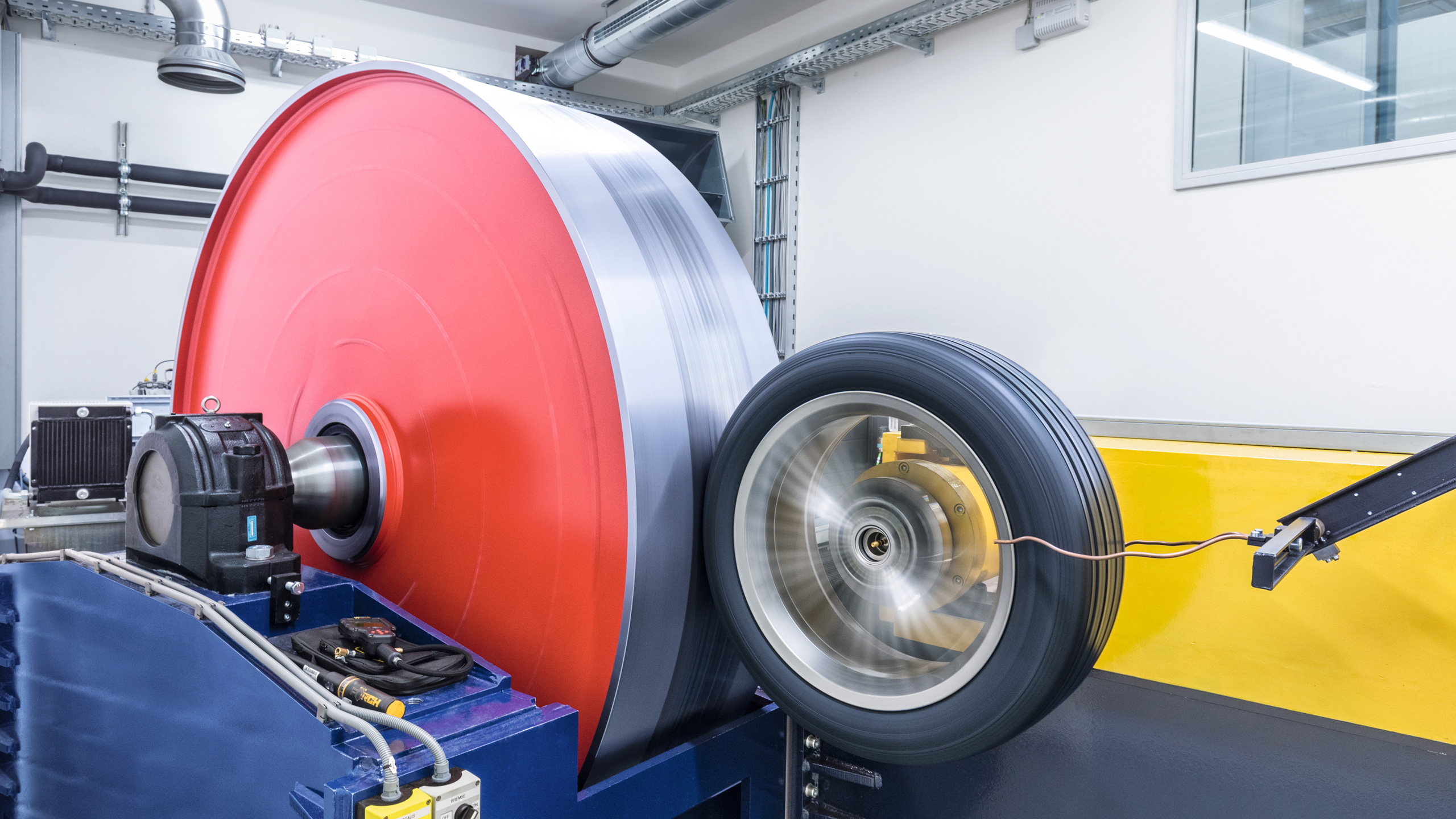Tire Testing: Rolling Resistance as a Stakeholder for Mobility Goals
In addition to its influence on driving behavior, tires have a significant impact on a vehicle’s energy consumption through rolling resistance. With an average share of around 25% of fuel consumption, it represents a decisive factor for efficiency, as well as the range of e-vehicles, and is therefore increasingly in the spotlight of current megatrends in the automotive industry. Last but not least, rolling resistance also has an impact on end customers’ purchasing decisions, as all tires have been classified into efficiency classes ranging from A to G since the introduction of the EU tire label in 2012. One gradation here corresponds to a fuel saving of around 0.1 l per 100 kilometers.

To drive development in this area, IAV operates a tire rolling resistance test bench that gives OEMs, tire manufacturers and also researchers the opportunity to test their tires and thus the potential for reducing CO2 emissions
Rolling resistance – the tire assessment parameter of the future
Particularly in urban areas at predominantly low driving speeds and thus the predominant place of use of modern e-vehicles, the proportion of rolling resistance is decisive. This resistance results to a large extent from the deformation of the tread and belt when the tire rolls. Nevertheless, when designing the test bench, in addition to paying attention to ISO measurements for EU tire labeling and the WLTP cycle, attention was paid to the ability to realize high driving speeds of up to 270 km/h. This enables our industrial partners to precisely design and select their tires.
One test bench for all cases
To determine the rolling resistance of a tire, a special test bench is required. A corresponding measurement according to ISO 28580 is carried out according to a standardized procedure: A wheel load of 80% of the maximum load is applied to the exposed wheel and pressed onto a drum with a diameter of 2 meters. The drum, which is driven by an electric motor, then accelerates to a speed of 80 km/h. The torque required to drive the wheel through the drum is the same as the torque required to drive the wheel through the drum. The torque required to keep the speed of the drum constant is measured at the drive and, in addition to the disturbance variables, also includes the rolling resistance of the tire. While the resistance of the free-running drum is known and can be calculated out, losses from the tire’s bearing and aerodynamic losses are determined and eliminated in a second measurement, which is performed approximately without wheel load. In a final step, the curvature of the drum is mathematically corrected, since the tire contact patch does not exactly resemble that of a flat contact patch. The result of this procedure is the rolling resistance coefficient, the decisive evaluation parameter for rolling resistance.
The test bench’s measurement results are regularly compared with the reference laboratory of Continental Reifen Deutschland GmbH and are thus internationally recognized. Reliable and consistent quality of the measurements is guaranteed by accreditation with the DAkkS (German Accreditation Body). Despite the high demand and relevance of the subject, it is important to react flexibly to customer requests and to be able to test a larger number of tires at short notice through good logistics and processes. In addition to manufacturers from the tire and automotive industries, IAV also uses the rolling resistance test bench for research questions, as it wants to enable fundamental research and play an active role in saving CO2. The conflicting goals of rolling resistance, performance and comfort represent an enormous challenge for tire and vehicle manufacturers, because vehicles are more dependent than ever on high-performance, low-wear tires with low rolling resistance to reduce CO2 emissions while at the same time ensuring safety. From a commercial perspective, the requirement for greater efficiency is also essential for commercial vehicles. This is why IAV is also focusing on the relevance of light small vehicles through to heavy trucks and buses (tire classes C1, C2 and C3) and is further expanding its expertise with a view to increasing logistics.
ISO Rolling Resistance Measurement
- Test According to ISO 28580 (EU-Tirelabeling)
- Tire class C1, C2 and C3 (cars, buses and lorries)
- Speeds up to 270 km/h
- Maximum wheel load of 63kN
- Adjustable camber angle
- Accreted according to ISO 17052 and Dakks
- Alignment with Continental AG (Virtual Lab)
- Basic research focus on CO2 emissions and range increase for electric vehicles
- Quality inspection for standard tires (identification of quality fluctuations in the product lifecycle)
- Agile and quick testing opportunities
